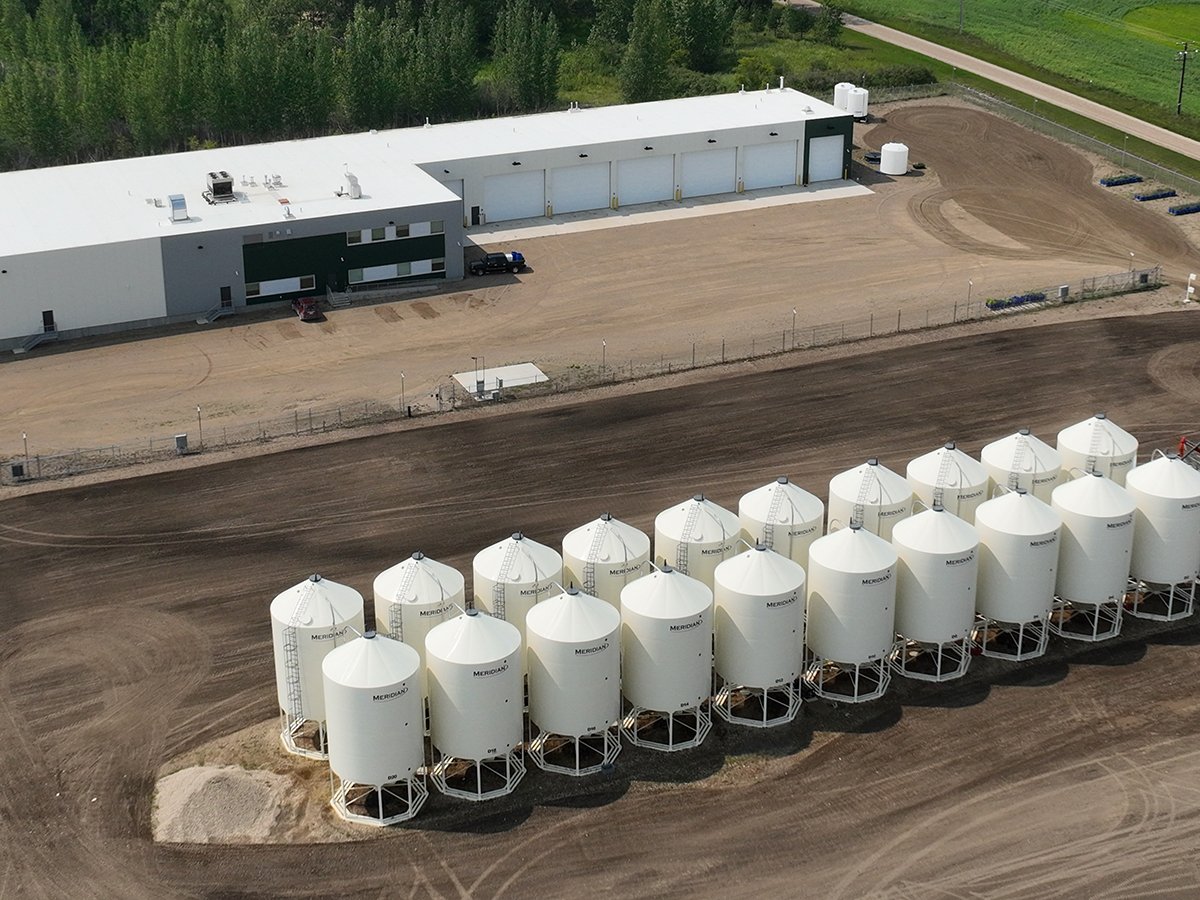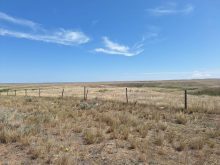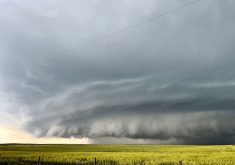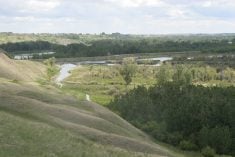In a thunderstorm:
Storm chasers live for extreme weather.
Whether it’s staying ahead of a tornado or pursuing a thunderstorm, passion drives them to their next weather event, again and again.
An awesome respect for the grandeur of nature is a trait shared by storm chasers.
“They love watching the sky, love the sound of thunder, the feel of rain on their head,” said Dave Carlsen, a meteorologist in Edmonton.
“Most sane people drive away from (storms), and we drive toward them, or at least in their general vicinity, anyway.”
Read Also

Saskatchewan firm aims to fix soil with compost pellets
In his business, Humaterra, Leon Pratchler is helping farmers maximize yields in the weakest areas of their fields through the use of a compost pellet.
Justin Hobson knows the lure of the storm.
“If there was a bigger word than love, I would use that,” said the Winnipeg meteorologist.
“I always say that weather comes first, but my girlfriend doesn’t like that.”
Hobson has been fascinated by thunderstorms for as long as he can remember. At age 12 he would ride his bike through thunderstorms in his south Winnipeg neighbourhood and use his handlebar-mounted Ghostbusters siren to alert neighbours.
“I was glued to the weather warnings that came on the TV or the radio. I was always looking out the window,” he said.
“The movie Twister came out later that year (1996) and from that point forward, I was hooked on severe thunderstorms and I wanted to be a storm chaser.”
Hobson eventually learned storm chasing doesn’t pay the bills, so he pursued the next best thing and became a certified meteorologist.
He witnessed his first tornado in Elie, Man., in June 2007. The EF5 (enhanced Fujita scale) event that struck the town remains Canada’s strongest tornado on record.
“That event just made my love for weather grow even more. That storm sealed the deal for finishing school and choosing meteorology as a career,” he said.
Hobson chases storms on his days off and books vacation during part of the storm season in June and July. He’s also a field instructor with the University of Manitoba’s storm chase course.
“About 20 students piled into three vans and caught a couple of tornadoes in South Dakota at the end of June,” he said.
“My passion has shifted to watching others witness their first tornado and see them react because I was there once.”
Carlsen saw his first tornado at age nine while looking out a window at his grandparents’ house in Wynyard, Sask.
“I knew at that time that I was going to study them and chase them for the rest of my life,” he said.
“Almost everyone I’ve met storm chasing has some moment in their life where they saw a storm that cemented in their mind that they wanted to do this.”
Hobson and Carlsen said storm chasers have many reasons for spending months pursuing thunderstorms as they drive up and down tornado alley, which reaches from central Texas to the Canadian Prairies and from eastern Colorado to western Pennsylvania.
Many are pure thrill seekers, but others are storm spotters who offer their observations of hazardous weather to relevant authorities.
Many recreational chasers submit photos and videos to researchers, Environment Canada and the National Weather Service.
Carlsen said storm-chasing tools vary, but the main ones are a vehicle, camera, laptop and cell phone. Some will mount a weather station on top of their vehicle to measure temperature, pressure, wind speed and moisture.
“The only things you really need for storm chasing are a car, your brain and your eyes. Everything else in addition to that is extra stuff that you don’t necessarily need,” he said.
“Once a storm is going on, you don’t need the radar. You just need to look.”
Greg Johnson is one of North America’s top professional storm-chasers and severe weather experts.
With more than 10 years experience, the Regina-based photographer, educator and entertainer enjoys chasing classic prairie thunder and lightning storms, tornados, hurricanes and blizzards.
“I’ve been fortunate to have documented, recorded and been at the biggest tornado events in history,” he said.
Johnson, along with a driver, videographer and “Flash,” his tornado truck, has developed a following that culminated in a TV show this year on CMT in Canada called Tornado Hunters.
Flash is a pickup truck outfitted with 750 pounds of LineX protective coating, including an external roll cage originally designed for the mining industry. It is equipped with 18 cameras inside and out.
Last year, the three-man crew and truck “hit” 120 to 130 storms during the five-month season and intercepted 51 tornadoes in 26 states and three provinces. They travelled 190,000 kilometres and had eight windshields destroyed by flying debris.
However, there’s a fine line between risk-taking and personal safety that can sometimes blur.
“There’s definitely scary moments, and if it wasn’t for fear we would probably barrel head first into some really crappy stuff. Obviously, we have to manage those risks,” Johnson said.
“We do the things we can to mitigate any kind of risk. But at the same time that’s part of the fun of it. I love going to work every day.”
May 12, 2003, at El Reno, Oklahoma, is a time and place permanently etched in Johnson’s mind because of a life changing narrow escape from a tornado. It killed four storm chasers and injured several more.
The El Reno tornado was the widest in recorded history at 4.2 km. Measurements from mobile Doppler weather radars revealed wind speeds in excess of 475 km-h inside the tornado.
Johnson said he and others had been photographing the tornado from a safe distance but it grew from a few hundred metres in slightly more than a minute.
“We were also caught in that tornado. We stayed in the truck, kept driving, trying to get out. We had a couple moments where we were in the air five or six feet. When the truck landed, it took a beating and had to be rebuilt. The windows all got blown out,” he said.
“We survived, but it was definitely a close call. We had vehicles flying around over our heads. We had a farmyard blow up beside us. We saw a two-ton 1960 era farm truck helicoptering through the sky in front of us and landed in the ditch that we were driving in. We had to swerve to avoid it.
“We were able to limp out of it. Start to finish, inside that tornado was probably 1.5 minutes. It was definitely the scariest moment of my life, not one I ever want to re-peat.”
Johnson said a tornado sounds like a jet engine as it travels through open country, but when it hits something, such as a town or other object, its pitch and decibel level rise dramatically.
“It’s a very distinct sound pattern,” he said.
The El Reno tornado did curb the enthusiasm of storm chasers, but Johnson said the number of people chasing storms is rising.
“I really encourage people to educate themselves, take the necessary precautions and use common sense. Don’t get too close, don’t stop the truck in the middle of the road, and watch out for others,” he said.
“People do a lot of stupid things on the highway. They get mesmerized by what’s going on in front of them and forget they’re on a public road.”
Added Carlsen: “The number one thing when you’re storm chasing is keeping safe. If you have to miss a storm because you didn’t have any road options to get to a good vantage point, well, you miss the storm. There will always be more storms.”
Safety tips from the storm chasers
- Seek shelter indoors and away from windows.
- Monitor weather radio.
- Do not hide under or near trees.
- Risks include lightning, tornadoes, flooding and hail.
- Take warnings seriously because any severe storm is capable of producing lightning and tornadoes.
- Stay indoors or in your vehicle.
- Avoid trees. This is where people are killed.
- Lightning can strike up to several kilometres away from a storm.
- Golfing is particularly bad during a lightning storm, but any outdoor sport should stop.
- It does not need to be raining for there to be a lightning risk.
- If you cannot get underground, get into a bathroom on the main floor.
- Do not hide under a highway overpass.
- Stay in your vehicle with your seatbelt on. Drive away if possible.
- If driving away is impossible, the last resort is to get to a low spot such as a ditch.
Source: www.tornadohunter.ca
















